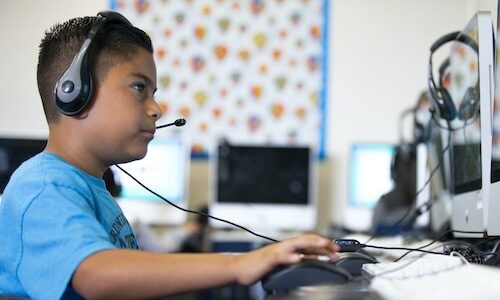
A multilingual education has countless benefits. According to the Office of English Language Acquisition, it may help improve cognitive flexibility, lead to more academic and professional opportunities, and even help us develop empathy. But how can educators accurately evaluate the skills of students who speak more than one language? MAP assessments can help.
My colleague Lynne Kulich and I sat down with Matt Hajdun, who recently worked at The Columbus School, near Medellín, Colombia, to learn more about the role of assessment there. The Columbus School is a US-accredited pre-K to grade 12 school where students learn in English and Spanish and receive both a US and a Colombian diploma.
What follows is a bit of our conversation with Matt. He spoke about dual-language programs, language development, choosing balanced assessment systems, and leveraging MAP assessment data in a predominantly Spanish-speaking school. Matt’s answers have been edited for length and clarity.
Can you say a bit about yourself and your role at The Columbus School?
My name is Matt Hajdun and I just finished my fourth and final year at the Columbus School. I served as the assistant director of learning for language development and arrived at the school prepandemic, which dramatically shifted the landscape of our school and long-term planning.
When I first arrived, the biggest part of my role was completing an audit through a process called Appreciative Inquiry. While the school has two language programs (English and Spanish), there was a perception that English learning was privileged over Spanish, despite Spanish being the heritage language of 99% of the students and 60% of the staff.
During our audit, we looked at everything from staffing and curriculum to learning environment and family partnerships to better understand how language was taught and assessed. The goal was to put our two language programs side by side to better understand what we were doing and ensure consistency. Following the audit, we began using MAP® Growth™ from grade 2 through grade 10, and MAP® Reading Fluency™ from kindergarten through grade 1 with all learners, and in grades 2 and 3 for selected learners, based on MAP Growth performance.
How do you decide what language to use for assessment?
Nearly all of our 1,850 students are heritage speakers of Spanish. Our kindergarteners are just beginning to learn English, and while 80% of their instruction is in English, we assess them in Spanish using MAP Reading Fluency: Foundational Skills at the start of the year. By the end of the year, we also add in MAP Reading Fluency in English to assess their foundational skills in both our program languages.
Starting in second grade, we assess in both English and Spanish using MAP Growth. If we believe a student won’t be successful, the teacher can make a decision to administer the assessment only in Spanish. Or if a teacher believes a student’s assessment scores aren’t accurate or are lacking essential information, we reassess learners using MAP Reading Fluency, again in both languages. Additionally, we have a policy to automatically assess students scoring below the 20th percentile on MAP Growth using MAP Reading Fluency. Our goal is to have valid and reliable reading data in both English and Spanish.
Can you talk about what instruction looks like?
We’ve been working hard on trying to follow some translanguaging pedagogies. At times, a limiting factor is the bilingual level of a student’s teacher. We have six homeroom classes per grade with two Spanish teachers who offer a 60-minute daily Spanish literacy class, and not all of our teachers are bilingual. While they might be able to provide outstanding language scaffolds, they are not all yet able to provide explicit instruction in contrastive analysis, that is, placing both languages side by side for direct comparison.
We are working toward prioritizing time exploring differences and similarities between English and Spanish using our biliteracy model. For example, our fourth-graders read biographies in English with their homeroom teacher, whose heritage language is English, and then they have an hour of Spanish class with a local Colombian teacher, who teaches a biography writing unit. The students get a chance to explore cognates and words that have high leverage between the languages. Students may notice that, in English, we say, “I am ___ years old” but in Spanish, we say, “I have ___ years.” We have what we call a biliteracy assessment, so at the start and end of the unit, students answer a few questions about biographies in English and then they do some further analysis in Spanish.
What are some of your biggest data wins with MAP Growth and MAP Reading Fluency?
During our audit, we realized that our assessments didn’t talk to each other. We relied on standardized, norm-referenced assessments in English, but leaned mostly on in-house assessments for Spanish. MAP assessments, plus our additional reading and writing assessments, now allow us to measure students’ abilities in English and Spanish, so we have more confidence that we’re meeting our students’ needs in both languages. We can more easily determine if a child is proficient, that is, meeting grade-level standards in both languages, just one, or neither.
We weren’t able to do that before, so planning intentional small groups, like our learning center support, was happening almost exclusively in English. Now we have a really intentional protocol for determining what language is best for an intervention. If a student isn’t proficient in reading in both languages, we know we should intervene in Spanish first.
Can you give us an example of how MAP assessment data has informed instruction?
Our teachers were really skilled at guided reading groups, but they weren’t really comfortable with what we call language development groups, which help kids strengthen specific language skills. We realized that what we really needed teachers to be able to do was support English language development. Assessment data proved to us that just teaching reading skills over and over again in Spanish wasn’t actually raising their literacy level.
Before, only about 25 to 45% of students were meeting grade-level standards in English, so it was very easy for us to slip into a deficit mindset. Suddenly, MAP data was showing us that more than 80% of students were meeting grade-level standards in Spanish. That really changed the conversation to, “Wow, look at all the strengths our students have. How can we leverage them? How can we bring their language acquisition up so we can see these same strengths in their literacy in English?”
What role do funds of knowledge play in your literacy practices?
In my earlier example of that biography unit, we deliberately chose two Colombian activists as the subjects in the assessment texts. There are some amazing US scientists and researchers in the world, but they’re not all relevant to our students. We wanted our students to feel that who they were learning about is relevant to them.
It makes sense that the more local and contextualized your curriculum is, the more background knowledge each young brain already has, and that leads to more enthusiasm and more motivation. It’s incredibly helpful to not just acknowledge the linguistic context of your learners but the sociocultural context as well, when you can.
Your focus shifted to building oral language skills. Why?
We look a lot at Scarborough’s Rope and the Simple View of Reading.
When we look at what language comprehension means and how much of a factor background knowledge and vocabulary play in a student’s ability to decode and understand, then we know that the ceiling of what a student can comprehend in writing is dependent on what they can comprehend orally. We realized that we need to support our students in developing their oral language and expanding their vocabulary before we ask them to read and write in a second language.
Before we critically reviewed our program and started using MAP assessments in both languages, we began traditional reading and writing in English in kindergarten, and the kids were frustrated. All of our kindergarten teachers are local, bilingual teachers who have 10+ year histories at the school. Focusing on oral language skills was a huge mind shift for them because, for good reason, they believed they had been doing the most equitable and right thing up until then.
We have added a Spanish phonics program to try and leverage the students’ heritage language skills. The more traditional reading work is done in Spanish, and we also work on building oral language and vocabulary in both languages throughout the year. Now only the last unit in kindergarten involves more traditional reading and writing in English to help kids transition to first grade.
Teachers have come to me with feedback like, “I didn’t know our students could do so much in the last unit.” One even told me we can’t ever go back to how it was before because our students are writing without asking for help. They’re actually sitting down and writing in English for 10 minutes because they have the vocabulary they need to avoid getting stuck. We used to ask students to read and write in English when they had maybe 100 to 500 words in their English vocabulary. By waiting until the end of the year, they have closer to 1,000 words and can be that much more successful when they write. That’s been exciting.
What advice would you give to schools who are just starting their journey with MAP assessments in Spanish?
Step back and consider the mindsets in your school. And as Simon Sinek says, start with the why. When are you assessing and why? In what languages are you assessing and why? What do all stakeholders believe about asset-based language learning and why? I think that can help educators understand why assessing in more than one language is an equitable practice.
I also think it’s important to start slowly. Encourage teachers to take the assessments themselves first so they really understand the assessment design and how they are assessing the same thing, just in different languages. It can help teachers to see that when students are able to use their heritage language in an assessment, the assessment doesn’t magically ask them easier questions; it supports them in demonstrating their understanding so you can acknowledge all that they can do.







